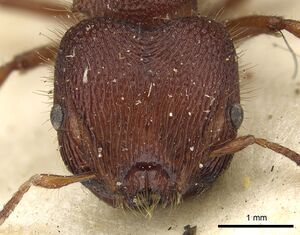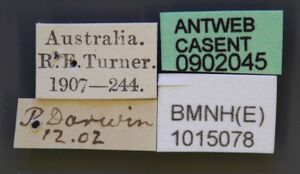Meranoplus diversus
| Meranoplus diversus | |
|---|---|

| |
| Scientific classification | |
| Kingdom: | Animalia |
| Phylum: | Arthropoda |
| Class: | Insecta |
| Order: | Hymenoptera |
| Family: | Formicidae |
| Subfamily: | Myrmicinae |
| Tribe: | Crematogastrini |
| Genus: | Meranoplus |
| Species: | M. diversus |
| Binomial name | |
| Meranoplus diversus Smith, F., 1867 | |
Distributed from the west coast to central Australia. Although a wide gap is present between the type locality (Geraldton) and most of the known collections, the species should be found throughout the arid and semi-arid zones of central and Western Australia.
Identification
Schödl (2007) - M. diversus is unique by the bifurcate clypeus in combination with the flanged promesonotal shield and the costate triangular petiole.
Keys including this Species
- Key to Meranoplus diversus group workers
- Key to Meranoplus of the southwestern Australian Botanical Province
Distribution
Distribution based on Regional Taxon Lists
Australasian Region: Australia (type locality).
Distribution based on AntMaps
Distribution based on AntWeb specimens
Check data from AntWeb
Countries Occupied
| Number of countries occupied by this species based on AntWiki Regional Taxon Lists. In general, fewer countries occupied indicates a narrower range, while more countries indicates a more widespread species. |

|
Estimated Abundance
| Relative abundance based on number of AntMaps records per species (this species within the purple bar). Fewer records (to the left) indicates a less abundant/encountered species while more records (to the right) indicates more abundant/encountered species. |

|
Biology
Castes
Worker
Images from AntWeb
   
| |
| Worker. Specimen code casent0902045. Photographer Ryan Perry, uploaded by California Academy of Sciences. | Owned by NHMUK, London, UK. |
Nomenclature
The following information is derived from Barry Bolton's Online Catalogue of the Ants of the World.
- diversus. Meranoplus diversus Smith, F. 1867: 527, pl. 26, fig. 2 (w.) AUSTRALIA (Western Australia).
- Type-material: holotype worker.
- Type-locality: Australia: Champion Bay (F.H. Du Boulay).
- Type-depository: BMNH.
- Forel, 1915b: 44 (m.).
- Status as species: Mayr, 1886c: 363; Dalla Torre, 1893: 136; Forel, 1915b: 44; Emery, 1924d: 229; Taylor & Brown, 1985: 67; Taylor, 1987a: 38; Taylor, 1990c: 37 (redescription); Bolton, 1995b: 251; Schödl, 2007: 387 (redescription); Heterick, 2009: 151.
- Distribution: Australia.
Unless otherwise noted the text for the remainder of this section is reported from the publication that includes the original description.
Description
Worker
Schödl (2007) - (n = 10). TL 5.85-6.95, HL 1.50-1.75, HW 1.75-2.03, FC 1.25-1.45, CS 1.63-1.87, SL 0.8-0.9, SI1 44-46, SI2 46-50, PML 1.05-1.27, PW 1.37-1.55, PMI 118-133, PMD 1.50-1.77, PMI2 107-120, ML 1.30-1.75, PTLL 0.40-0.50, PTLH 0.60-0.75, PTDW 0.48-0.64, PPLL 0.38-0.50, PPLH 0.48-0.78, PPI 63-79, PPDW 0.48-0.60, PT/PP 100-109.
Mandible with three teeth. Clypeus medially deeply excavated, distinctly acutely bidentate, longitudinally carinulate, sunk into prolonged anterolateral frontal projections. Head distinctly wider than long (CI 112 - 120), lateral sides almost straight, feebly narrowing anteriorly, preoccipital corners bulbously rounded, the rear margin emarginate. Frontal carinae evenly sinuately narrowed towards clypeus, distinctly narrower than head width (FI 132 - 145). Antennal scrobes in lateral view surpassing middle of length of head posteriorly, distinctly transversely carinulate in posterior half, occasionally with additional shagreening, posteriorly rather distinctly demarcated from remainder of head. Genae and ventrolateral sides of head carinate to rugose, preoccipital lobes reticulate. Compound eyes moderately large (EL 0.25-0.32, REL 0.17-0.20, with 15-20 ommatidia in the longest row) situated distinctly in front of middle of lateral sides of head, dorsal ocular margin not reaching ventral scrobal margin.
Promesonotum wider than long (PMI 118-133), somewhat flanged and broadly translucently margined, concealing lateral sides of mesosoma and propodeal declivity. Propodeal spines of medium length (PSL 0.58-0.78) situated above middle of length of declivity, acute and slightly arcuate when seen from above.
Petiole distinctly higher than long (PTI 66-73), in profile wedge-shaped with anterior face straight and unsculptured, posterior face convex, distinctly and regularly costate. Postpetiole elongately nodiform distinctly tapering towards base, with ventral medium sized tooth, rugose throughout.
First gastral tergite with dense microreticulum, basal half with additional distinct striation. Dorsum of head longitudinally costulate, additionally with rugulae and only few transverse meshes, at very rear reticulate, interspaces with microsculpture; with scattered, suberect to erect hairs. Promesonotal shield coarsely rugoreticulate, with pilosity consisting of short decumbent and longer more or less erect hairs.
Concolorous brown to fuscous, frequently with the gaster somewhat brighter.
Type Material
- Holotype, worker, Champion Bay, Western Australia, Australia, The Natural History Museum.
References
- Forel, A. 1915b. Results of Dr. E. Mjöbergs Swedish Scientific Expeditions to Australia 1910-13. 2. Ameisen. Ark. Zool. 9(1 16: 1-119 (page 44, male described)
- Heterick, B. E. 2009. A guide to the ants of South-western Australia. Records of the Western Australian Museum, Supplement 76:1-206.
- Heterick, B.E. 2021. A guide to the ants of Western Australia. Part I: Systematics. Records of the Western Australian Museum, Supplement 86, 1-245 (doi:10.18195/issn.0313-122x.86.2021.001-245).
- Heterick, B.E. 2022. A guide to the ants of Western Australia. Part II: Distribution and biology. Records of the Western Australian Museum, supplement 86: 247-510 (doi:10.18195/issn.0313-122x.86.2022.247-510).
- Mitra, A. 2013. Function of the Dufour’s gland in solitary and social Hymenoptera. Journal of Hymenoptera Research 35, 33–58 (doi:10.3897/jhr.35.4783).
- Schödl, S. 2007. Revision of Australian Meranoplus: the Meranoplus diversus group. Memoirs of the American Entomological Institute. 80:370-424.
- Smith, F. 1867. Descriptions of new species of Cryptoceridae. Trans. Entomol. Soc. Lond. (3) 5: 523-528 (page 527, pl. 26, fig. 2 worker described)
References based on Global Ant Biodiversity Informatics
- Schödl S. 2007. Revision of Australian Meranoplus: the Meranoplus diversus group. Memoirs of the American Entomological Institute 80: 370-424.

